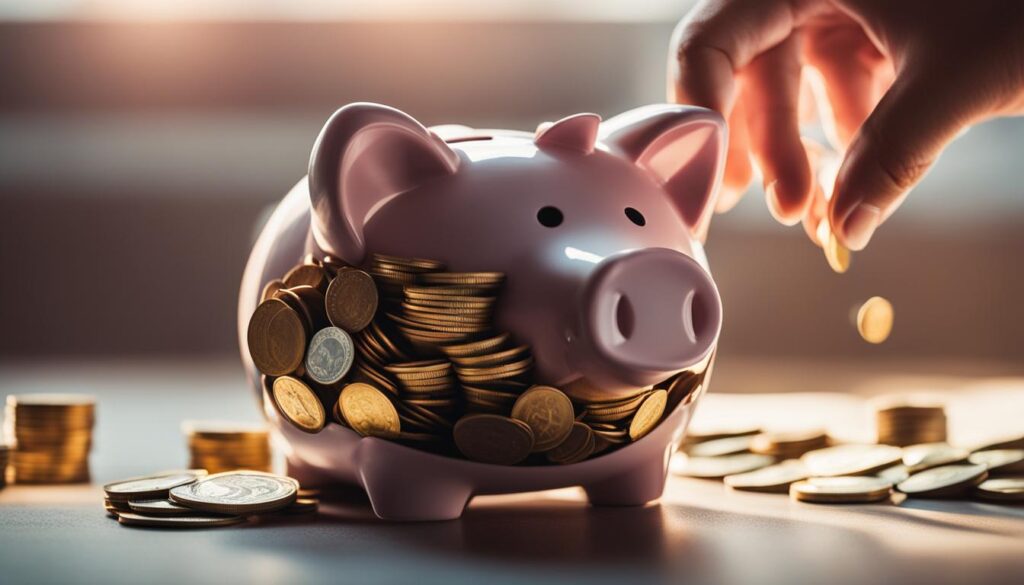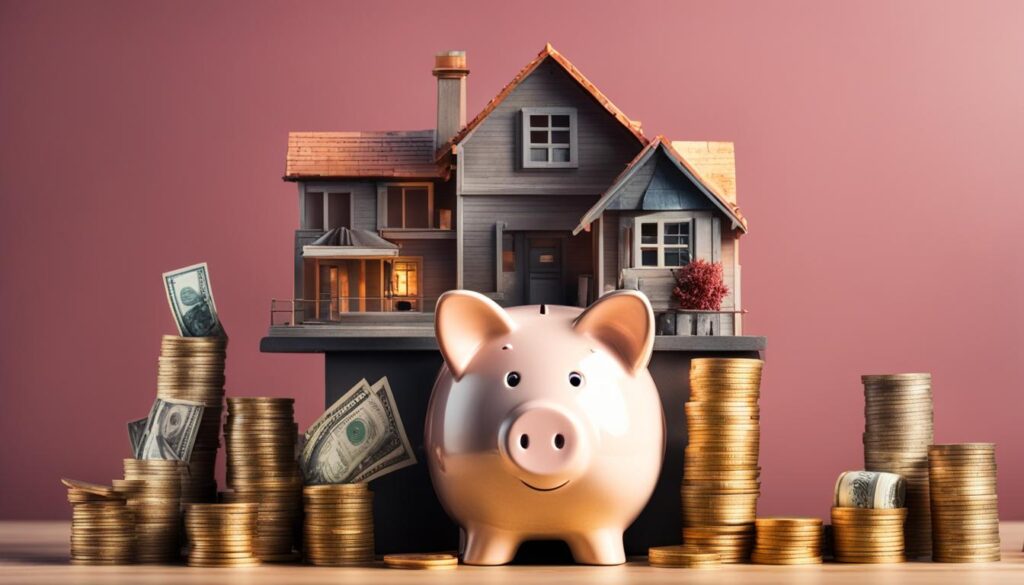According to a 2022 report from Bankrate, less than half of Americans have enough money saved to cover an unexpected expense of $1,000. In this guide, we will discuss the importance of an emergency fund and provide tips on how to start building one.
Key Takeaways:
- Building an emergency fund is crucial for financial security
- An emergency fund provides a safety net for unexpected expenses
- Aim to save three to six months’ worth of living expenses
- Open a high-yield savings account dedicated to your emergency fund
- Automate your savings to ensure consistent contributions
What is an emergency fund and why is it important?
An emergency fund is a crucial financial safety net that provides protection against unexpected expenses and financial emergencies. It is a dedicated savings account specifically set aside for situations such as job loss, medical emergencies, or car repairs. Having an emergency fund is essential for maintaining financial security and preventing debt.
One of the main reasons an emergency fund is important is its ability to provide financial security. Life is unpredictable, and unexpected expenses can arise at any time. Without an emergency fund, individuals may be forced to rely on credit cards, loans, or other forms of debt to cover these expenses. This can lead to long-term financial struggles and create a cycle of debt.
“An emergency fund is like a financial safety net, allowing you to avoid accepting undesirable jobs or resorting to credit card debt or high-interest loans.”
Having an emergency fund also offers peace of mind. Knowing that you have savings to fall back on in times of need can relieve stress and anxiety. It gives you the freedom to make decisions based on what is best for your financial well-being, rather than being forced into unfavorable situations.
Overall, an emergency fund is an essential tool for preventing debt, maintaining financial security, and providing peace of mind. It allows individuals to navigate unexpected expenses without resorting to high-interest loans or credit cards. By prioritizing the building of an emergency fund, individuals can protect themselves from the financial burdens that can arise from unexpected situations.
How much money should be in your emergency fund?
When it comes to building an emergency fund, one of the most common questions is, “How much money should I have saved?” While there is no one-size-fits-all answer, most financial experts recommend aiming for three to six months’ worth of living expenses. This ensures that you have enough money to cover essential costs if you were to face a sudden financial challenge, such as a job loss or a medical emergency.
To determine your savings goal, start by calculating your monthly expenses. Include necessities such as rent/mortgage, groceries, insurance, healthcare, utilities, and transportation. Don’t forget to factor in any debt payments you may have, as well as any additional expenses that are specific to your lifestyle. Once you have a clear understanding of your monthly expenses, multiply that amount by the number of months you want to save for.
If you’re starting from scratch, it’s recommended to aim for an initial savings goal of $500 to $1,000. This will provide you with some immediate financial security while you work towards building a larger emergency fund. To stay on track, consider setting smaller milestones along the way. For example, aim to save one month’s worth of expenses within the first three to six months, and gradually increase your savings from there.
| Expenses | Monthly Amount |
|---|---|
| Rent/Mortgage | $1,200 |
| Groceries | $400 |
| Insurance | $150 |
| Healthcare | $200 |
| Utilities | $100 |
| Transportation | $300 |
| Debt Payments | $500 |
| Total Monthly Expenses | $2,850 |
For example, based on the table above, if your monthly expenses total $2,850, you would aim to save between $8,550 to $17,100 for a three to six months’ worth of living expenses.
Steps to Build an Emergency Fund
Building an emergency fund is a crucial step towards financial security. It ensures that you have a safety net to rely on during unexpected circumstances. Here are the steps you can follow to start building your emergency fund:
- Assess your monthly expenses: Begin by evaluating your monthly expenses to determine a realistic goal for your emergency fund. Consider essential expenses such as rent, groceries, insurance, healthcare, utilities, and transportation.
- Open a dedicated savings account: Once you have a savings goal in mind, open a high-yield savings account specifically designated for your emergency fund. Look for an account with no or low fees and competitive interest rates to maximize your savings.
- Set up automatic deposits: To ensure consistent savings, set up automatic deposits from your checking account to your emergency fund. Start with an amount that you can comfortably afford and gradually increase it over time. Automatic deposits eliminate the risk of forgetting to save and make it easier to build your emergency fund.
By following these steps, you can steadily build your emergency fund and create a financial safety net for the future. Remember to regularly reassess your savings goal and make adjustments as needed. It’s important to prioritize your emergency fund and treat it as an essential part of your overall financial plan.

Why Automatic Deposits are Beneficial
Automatic deposits play a crucial role in building an emergency fund. By setting up this feature, you ensure consistent savings without relying solely on your willpower to transfer money regularly. Here are a few advantages of automating your deposits:
- Consistency: Automatic deposits ensure that you save a predetermined amount regularly, regardless of any disruptions or distractions in your day-to-day life.
- Discipline: Automating your savings helps you maintain discipline in your financial habits. It eliminates the temptation to spend the money meant for your emergency fund on non-essential items.
- Peace of mind: With automatic deposits, you can have peace of mind knowing that you are consistently working towards your savings goal. It reduces financial stress and provides a sense of security.
By making use of automatic deposits, you can make building your emergency fund a seamless and effortless process. Take advantage of this convenient feature and prioritize your financial well-being.
Where to Put Your Emergency Fund
An emergency fund is a vital financial safety net that provides peace of mind during unexpected situations. But where should you keep your emergency fund to ensure accessibility and growth? Look no further than a high-yield savings account.
A high-yield savings account is the best place to park your emergency fund. These accounts offer competitive interest rates, allowing your savings to grow over time. Additionally, they provide easy access to your funds when you need them most. Online-only banks often offer the highest interest rates, so consider opening an account with one of these institutions.
By keeping your emergency fund in a separate high-yield savings account, you create a clear distinction between your regular savings and your emergency fund. This separation helps you resist the temptation to dip into your emergency fund for non-emergency expenses.
Remember that accessibility is key when it comes to your emergency fund. While other investment options may offer higher potential returns, they may not provide the immediate access you need during an emergency. It’s crucial to have your emergency funds readily available, so prioritize liquidity over potential gains.

The Benefits of a High-Yield Savings Account for Your Emergency Fund
There are several benefits of choosing a high-yield savings account for your emergency fund:
- Competitive interest rates: High-yield savings accounts typically offer interest rates that are higher than regular savings accounts. This allows your emergency fund to grow faster over time.
- Ease of access: Online banking makes it convenient to manage your emergency fund. You can easily transfer funds between accounts and access your money whenever you need it.
- Safety: High-yield savings accounts are FDIC-insured up to $250,000 per depositor, providing peace of mind that your funds are protected.
In summary, a high-yield savings account provides the perfect blend of accessibility and growth for your emergency fund. By choosing this option, you can ensure that your funds are easily accessible in times of need while also earning a competitive return on your savings.
Tips for Saving More Money
When it comes to saving money, implementing effective strategies can make a significant difference in achieving your financial goals. Whether you’re looking to build your emergency fund or save for a specific milestone, such as buying a house or starting a family, these tips can help you increase your savings and improve your overall financial well-being.
Create a Budget
One of the most powerful tools for saving money is creating a budget. A budget allows you to track your income and expenses, giving you a clear picture of where your money is going. By identifying areas where you can cut back, such as dining out or entertainment expenses, you can free up more money to put towards your savings goals. Be sure to set realistic goals within your budget and regularly review and adjust it as needed.
Automate Your Savings
Automating your savings is a smart way to consistently put money aside without having to think about it. Set up automatic transfers from your checking account to your emergency fund or savings account. Start with a small, manageable amount and gradually increase the transfer as your income allows. By automating your savings, you’ll be less tempted to spend that money and more likely to reach your savings goals.
Look for Opportunities to Save
Saving money doesn’t have to be limited to cutting expenses. Look for opportunities to save in other areas of your life as well. For example, consider switching to a lower-cost cell phone plan, shopping for deals and discounts before making a purchase, or finding ways to save on utility bills. Every small change can add up to significant savings over time.
By implementing these tips, you can take control of your finances and save more money. Remember, saving money is a journey, and it requires discipline and consistency. Stay focused on your goals and make saving a priority in your financial plan.

Conclusion
Building an emergency fund by the age of 30 is a crucial step towards financial security. By implementing good savings habits, you can protect yourself from unexpected expenses and have peace of mind knowing you are financially prepared.
Start small and gradually increase your savings over time. Aim to save at least three to six months’ worth of living expenses in a high-yield savings account. This will provide you with a safety net during challenging times and prevent you from relying on credit cards or loans that can lead to debt.
Make saving a priority by automating your savings. Set up automatic transfers from your checking account to your emergency fund to ensure consistent contributions. By doing this, you’ll develop a habit of saving and make it easier to reach your savings goals.
Remember, your emergency fund is meant for unexpected emergencies only. Avoid using it for non-emergency expenses to maintain the integrity of your fund. Keep an eye on your expenses and look for opportunities to save more money by cutting back on unnecessary spending.
FAQ
What is an emergency fund and why is it important?
An emergency fund is a savings account specifically set aside for unexpected expenses, such as job loss, medical emergencies, or car repairs. It is important to have an emergency fund to prevent going into debt during financial emergencies. It provides financial security and peace of mind, allowing you to avoid accepting undesirable jobs or resorting to credit card debt or high-interest loans.
How much money should be in your emergency fund?
Most experts recommend having three to six months’ worth of living expenses saved in an emergency fund. This includes expenses such as rent/mortgage, groceries, insurance, healthcare, utilities, and transportation. Start by determining a realistic savings goal based on your monthly expenses and gradually work towards it. If starting from scratch, aim to save $500 to $1000 initially and then build up to three to six months’ worth of living expenses.
What are the steps to build an emergency fund?
Step 1 is to determine a realistic goal for your emergency fund by assessing your monthly expenses. Step 2 is to open a high-yield savings account dedicated to your emergency fund. This account should have no or low fees and offer a competitive interest rate. Step 3 is to set up automatic deposits from your checking account to your emergency fund to ensure consistent savings. Start with what you can afford and gradually increase the amount over time.
Where should I put my emergency fund?
The best place to put your emergency fund is in a separate high-yield savings account. This ensures that the funds are easily accessible in case of emergencies, while also earning competitive interest rates. Consider online-only banks for the highest interest rates. Keeping your emergency fund separate from your regular savings account prevents temptation to spend it on non-emergency expenses and helps you maintain a dedicated fund.
What are some tips for saving more money?
To save more money, create a budget to track your expenses and identify areas where you can cut back. Set realistic goals and save in stages, starting with smaller achievable amounts and gradually increasing your savings. Automate your savings by setting up automatic transfers from your checking account to your emergency fund. Look for opportunities to amplify your savings by adding any extra money you come across.
What Are Some Smart Investment Strategies for Building an Emergency Fund at 30?
Smart investing tips in your thirties should include building an emergency fund. Set aside a small portion of your income each month and invest it in low-risk, easily accessible accounts. Consider automating contributions to ensure consistency. Diversify your emergency fund between cash, high-yield savings accounts, and short-term investments. Aim to accumulate three to six months’ worth of living expenses to secure financial stability.

